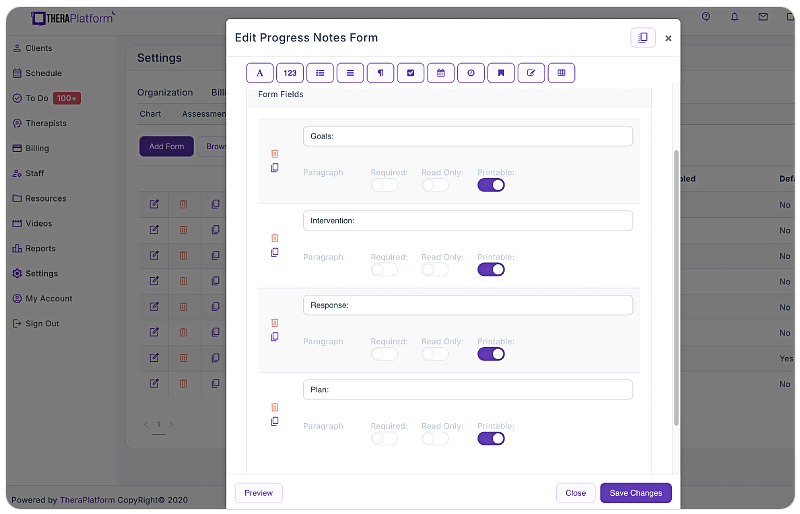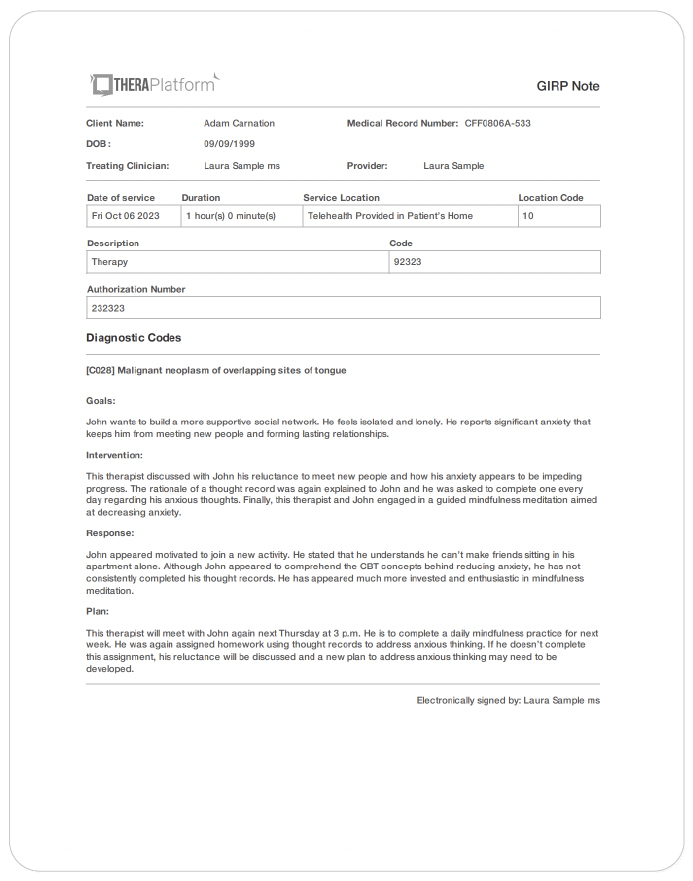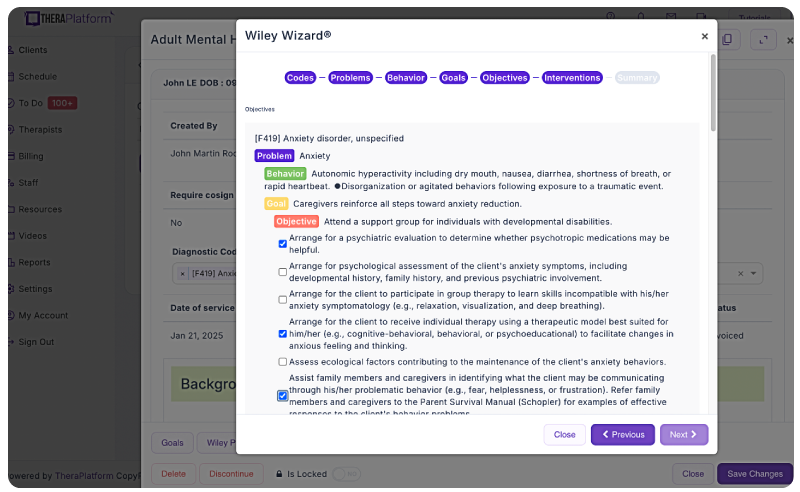Group therapy notes

Group therapy notes may seem alarming for therapists who already dislike writing progress notes and now need to write multiple notes for their group therapy clients. But understanding the most efficient method of writing group therapy notes is a good skill to master as group therapy has increased substantially in popularity as a mental health treatment modality following the pandemic.
Summary
- While you can use shared sections for group details and session summaries, each group member needs a personalized note highlighting their behaviors, participation, and interactions, especially as insurers require proof of individualized treatment.
- A strong group note should cover the group topic, client appearance and engagement, group dynamics, individual interactions, goal progress, and plans for future sessions. Confidentiality is essential—never include identifying information about other members.
- Using adapted formats like SOAP, GIRP, or DAP can streamline documentation. Therapists are encouraged to follow a consistent template while still capturing the therapist’s interventions and client responses within the group context. Download my free notes templates.
- EHR features such as customizable templates, note duplication, secure storage, efax integration, and electronic signatures help therapists save time, maintain HIPAA compliance, and efficiently manage group documentation.
Streamline your practice with One EHR
- Scheduling
- Flexible notes
- Template library
- Billing & payments
- Insurance claims
- Client portal
- Telehealth
- E-fax

There are several reasons behind this growth: You can treat more people at once (and there is more demand than ever), it is cheaper for clients, and - in many instances - it is as effective as individual therapy. Here is what you need to know to make writing group therapy notes a more manageable exercise.
Group therapy notes vs. individual therapy notes
While it would be easier to write one note that covers every member of a group, insurance companies will likely want an individualized note for each group member. You might also want to make one overall note for your own records but that is a personal preference.
When writing a group therapy note, therapists need to keep in mind that group notes have a different concentration than individual notes. While an individual note is committed to one person (and possibly the therapist), a group note takes into account the individual and their interactions with other group members.
The influence a person has on the group and their reactions to other members are the focus of a group note. This emphasis on the group process is in contrast to the client’s individual progress which predominates in an individual therapy note.
Practice Management + EHR + Telehealth
Mange more in less time in your practice with TheraPlatform

.
What to include in group therapy notes
Here is what you want to include in a group therapy note:
- Basic group information: This includes the name of the group (i.e., what is the group for?) and the topic of the day. The date, duration, and number of clients attending are also commonplace.
- Client information and observations: Include the name, appearance, and perceived attitude of the specific group member. Objective and subjective observations of the client (e.g. motivation and mood) are also placed here.
- Summary of group session: This part evaluates general group dynamics and progress. For example, if it is a substance abuse group, you will want to write about how the session went as a whole in relation to reducing substance abuse. You will also want to comment on any general themes that arise within the group. The general tone of the group may also be mentioned. This part of the note does not delineate between specific group members.
- Specific interactions between the client and the group: This is the most individualized part of a group note. It considers the effect the person has on the group and the impact the group has on them. You will want to record significant interactions the individual has with other group members. Alternatively, you also want to note if the group member is not exhibiting much participation and if that is unusual.
- Progress toward treatment goals: Although individual goal progress is not the primary focus of a group therapy note, it always needs to be noted. After all, a person is involved in group therapy to further their individual goals. The therapist wants to note how group interactions and content are related to the goals in the individual’s treatment plan.
- Plan for future sessions: The therapist wants to look forward and plan what is coming next in the treatment process. This may include what homework is given, the topic of the next session, and when that session is taking place.
Five therapist tips for writing group therapy notes
The following are therapist considerations when writing therapy notes:
- Confidentiality: Confidentiality always needs to be at the forefront when writing a group therapy note. You need to talk about the individual client’s interactions but you can’t provide any identifying information about other group members. This can be a lot to keep track of when you are writing multiple notes for the same group session. Take your time and make sure you get it right. The worst thing that can happen is another group member’s name showing up in a client’s official record. This is a breach of the therapist’s ethical obligations and a clear HIPAA violation.
- Cut and paste: Many parts of a group note are the same for every group member. For example, the “group information” and the “summary of the group session” do not need to be individualized. To make it easier, just keep that the same for every person’s note. That way, you only have to individualize a few parts in each note. It will save you a lot of time and trouble.
- Understand your audience: Group therapy is often used in conjunction with individual therapy or some other form of treatment (e.g., medication management). Another professional should be able to read the group notes and use that information to enhance their part of the treatment. In addition, you can never be sure exactly who will see the notes. Notes need to be clear, concise, and professional. A client’s therapy documentation can follow them for the rest of their lives.
- Follow templates: A group note can follow the same general template as an individual note. For example, if you write individual notes using the GIRP format, the group notes can use that basic format as well. Within whatever template you choose, however, you will want to adapt it for group use. This might mean adding additional sections or just incorporating the information within the given format. In general, using a note template helps the clinician organize the notes and emphasize particular aspects of the treatment. Here is an example of a group therapy note using the GIRP note format.
Don’t forget the therapist: A lot is going on in a group session. You have several interactions occurring on a multitude of topics. It is easy for the therapist’s role to get lost in all of that. Some note templates specifically ask for the therapist’s intervention (e.g., GIRP and BIRP notes) but, if they don’t, make sure to include a line or two about what you are doing to facilitate the group process. After all, you are part of the group too.
One of group therapy’s strengths is that it allows more people to receive treatment at once. Still, writing therapy notes for all the members of a treatment group may appear to be a daunting task. However, by keeping in mind several suggestions, therapists can create effective group therapy notes with little more effort than they would spend in writing an individual note.
Watch this video to learn how to simplify note taking
→ Start My Free Trial
→ Start My Free Trial
Group therapy note examples
Due to the multiple people involved, writing group therapy notes can provide some complications for therapists. Here are three examples of group notes to give you an idea of different ways you can write group therapy notes:
Example #1-The Comprehensive Group Note
This first example has all the recommended components of a group therapy note:
Substance Group Progress Note
Client: John Doe
Date: 5/1/2024
Number of Clients attending group: 8
Group topic of the day: Relapse Prevention
Client observations: Client appeared in a fine mood but not overly enthusiastic about group. He kept his head down and seemed slightly avoidant.
Summary of group session: Group discussed the concept of relapse. A couple of group members shared their particular relapse stories. Group acknowledged the difficulty of staying sober and noted that relapse is a common part of recovery, not a death knell. Strategies for relapse prevention were discussed.
Interactions: John D. was unusually quiet for today’s group. He did not speak about any personal examples of relapse. His participation overall was nominal. He looked a bit distracted and did not engage much with others.
Progress: John did not make much progress with his treatment goals in today’s group. His participation was minimal. He did not appear to want to discuss any of his personal struggles with relapse, of which there are several. He could have processed his own relapse difficulties with the group and chose not to. John completed his homework but it lacked effort.
Plan: Group was asked to read the relapse chapter in their workbook and complete all exercises. This therapist will talk to John about his reluctance to share in group during his individual session. Next group session is on 5/13/2024.
Example #2-The SOAP group therapy note
One of the most popular behavioral health note formats is the SOAP note. Because group notes do not have a set format, they can be adapted to fit any type of note template. The following example is a group note adapted to fit the SOAP format:
Substance Group Progress Note
Client: John Doe
Date: 5/1/2024
Group Topic: Relapse Prevention
Number of Clients attending group: 8
Subjective: John appeared to feel stand-offish towards group today. He seemed annoyed when he was asked a question. He kept his head down throughout the group session and did not seem to want to interact with other group members.
Objective: When addressed at the beginning of group, John said he was “fine”. Later on, when asked a question he said he had nothing to say at the moment. His participation was minimal. At one point, John closed his eyes and appeared to be sleeping. He completed the homework from last week but it was not very thorough.
Assessment: John made little progress toward his treatment goals in today’s group. Although John has a history of relapse behavior, he was reluctant to share his experiences with the group. John may be having some mood disturbance as this is not his usual attitude towards group. John is usually an active and valued participant.
Plan: This therapist will address John’s avoidant behavior toward treatment this week. Group was asked to read the post-relapse chapter in their workbook and complete all relevant exercises. Next group session is on 5/13/2024.
Note: Some clinicians might favor the similar DAP note format over a SOAP note because it gives the therapist more flexibility in what data they can include, rather than breaking it down into subjective and objective observations.
Example #3-The GIRP group therapy note
Another popular type of therapy note, the GIRP note, emphasizes therapist intervention and the clients’ response to that intervention in relation to their treatment goals. The following is a group note adapted to the GIRP format using the same fictional client, John D:
Substance Group Progress Note
Client: John Doe
Date: 5/1/2024
Group Topic: Substance abuse relapse
Number of Clients attending group: 8
Goals: The group therapy session focused on preventing substance abuse relapse after a period of sobriety. Preventing relapse is one of John’s treatment goals due to his relapsing multiple times after maintaining sobriety from opioid use.
Interventions: This therapist led the group through its weekly check in. The group was then asked to discuss their histories of relapse, focusing on the factors that appeared to act as “triggers”. Next, the group was asked to propose relapse prevention strategies to combat future triggers and temptations. The group ended with a brief guided meditation exercise.
Response: Overall group participation and enthusiasm was good. John’s reaction to group was not as positive. He responded that he was “fine” when asked to check in. He refused to discuss his own history of relapse. He kept his head down throughout the group and even appeared to be sleeping at one point. His participation was minimal. It is likely that something is affecting John, as this is unlike John’s usual group behavior.
Plan: The next therapy session will be on 5/13/2024 and address how to get back on the path to sobriety post-relapse. Group was assigned the next workbook chapter to complete. John’s group behavior will be addressed in individual session this week.
Group therapy notes are an instructive way to keep track of client progress in a group therapy setting. While they have no set format, therapists will do well to emphasize the interplay between the individual and the group.
Advantages of utilizing an EHR for group therapy notes
- Customizable templates streamline note creation: Some EHRs like TheraPlatform provide therapists with built-in templates for notes, simplifying the note-writing process. These templates can be tailored to meet the specific requirements of therapists' practices. Storing notes centrally in EHRs enhances accessibility.

- Flexible note template builder: Some EHRs offer a template builder that serves as a base for note documentation. These templates are populated with necessary fields, enabling clinicians to easily complete various sections of a group therapy notes. Mental health professionals can customize templates to align with their preferred documentation style. The intuitive template builder saves time and offers customization options.

- HIPAA-compliant storage: TheraPlatform prioritizes the secure storage of GIRP notes by employing encryption and robust security measures. They also provide legally-binding Business Associate Agreements, ensuring compliance with HIPAA regulations for safeguarding Protected Health Information (PHI).
- Secure and convenient note sharing: Group therapy notes may need to be shared. EHRs facilitate secure and easy access to group therapy notes, saving time compared to traditional paper-based methods like manual retrieval or faxing.
- Integration with Wiley Treatment Planners: TheraPlatform integrates with Wiley Treatment Planners, enabling therapists to quickly access evidence-based treatment objectives, interventions, homework assignments, and diagnostic codes like ICD-10 and DSM-5. This integration streamlines treatment planning, saving clinicians valuable time.

- Therapy note duplication: While the content of therapy notes may change from session to session, certain information can be repetitive. TheraPlatform allows therapists to copy and paste relevant notes and retrieve data from previous sessions. Homework assignments from earlier plans can also be carried over, and notes can be edited as needed.
- Effortless signatures: TheraPlatform's Pro and Pro Plus plans offer the convenience of requesting electronic signatures directly on notes. This feature is particularly useful when working with pediatric clients, as it allows for signatures from parents or legal guardians. Clients can easily download and print these documents as required.
- Efax integration: TheraPlatform, an all-in-one EHR, practice management, and teletherapy solution, offers efax integration. This eliminates the need to switch between multiple services, saving time and reducing costs by enabling seamless sending and receiving of documents such as GIRP notes via efax directly within TheraPlatform. No more fighting with the fax machine!
Additional tools to help with note taking
Therapists can also take advantage of EHRs (such as TheraPlatform) that offer integrations with Wiley treatment planners and built-in outcome measures to ensure consistent data collection on progress from session to session. The best part about partnering with a modern EHR is the time you save on formulating the actual notes and scoring.
What is Wiley Treatment Planner?
Wiley Treatment Planner is a widely used clinical resource designed to help mental health professionals and other therapists efficiently create treatment plans for their clients. In addition to treatment plans, the company also provides prewritten therapy notes for some diagnostic codes. It is part of the "PracticePlanners" series published by Wiley.
Features of Wiley Treatment Planner includes:
- Prewritten, evidence-based treatment goals, objectives, and interventions
- Treatment planners tailored to specific populations and problems, including adults, children, adolescents, couples, families, addictions, and more
- Alignment with the diagnostic criteria from the DSM-5 and ICD-10
- Prewritten therapy notes
Is there an online version of Wiley Treatment Planner and how can I get the Wiley Treatment Planner?
Wiley Treatment Planner company partnered with a select number of EHRs for mental health providers to make treatment planners available online. TheraPlatform’s EHR offers the Wiley Treatment Planner as an add-on for both assessment and treatment plans and therapy notes, such as notes. You can edit prewritten notes and add your own with any therapy template on TheraPlatform.

Leveraging an EHR like TheraPlatform helps therapists enhance the quality and efficiency of their group therapy notes, streamline workflows, secure storage and easily access records.
Streamline your practice with One EHR
- Scheduling
- Flexible notes
- Template library
- Billing & payments
- Insurance claims
- Client portal
- Telehealth
- E-fax

Resources
Theraplatform has numerous progress note templates to make documentation a breeze. Theraplatform is an all-in-one teletherapy, practice management, and electronic documentation software for clinicians. Try a 30-day free trial of Theraplatform today. No credit card required. Cancel anytime.
More resources
- Therapy resources and worksheets
- Therapy private practice courses
- Ultimate teletherapy ebook
- The Ultimate Insurance Billing Guide for Therapists
- The Ultimate Guide to Starting a Private Therapy Practice



